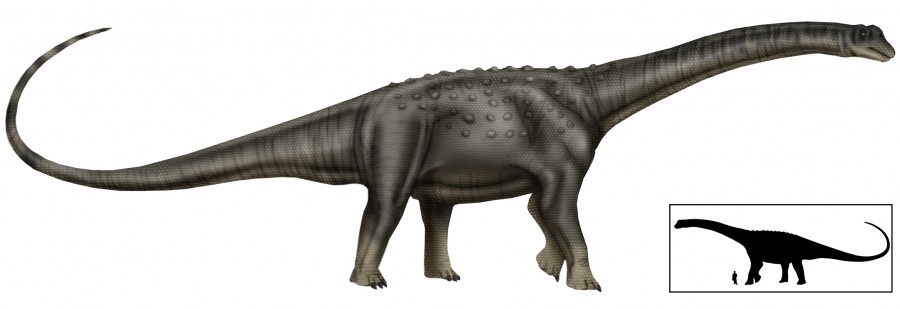Titanosaurus: World’s Largest Dinosaur
An artist’s rendering of the Titanosaur
The American Museum of Natural History in New York has been the largest natural history museum in America and one of the largest in the world since its completion in 1930. It is home to 45 exhibition halls, 225 full time scientists, and a collection of 32 million individual specimens ranging from plants, animals and fossils to human artifacts and minerals. Although the outer facades have not changed from their castle-like mixture of columns and crenelations, inside the museum work is always ongoing to acquire and display new centerpieces and improve the museum both for visitors and science. On January 15, the paleontology department outdid themselves with the unveiling of the new sauropod (long necked) dinosaur skeleton they are referring to simply as “The Titanosaur”.
The “titanosaur” skeleton is 122 feet long and 19 feet high, and has replaced a fleshed out statue of a much smaller dinosaur called Barosaurus in the 4th Floor Wallach Orientation hall, at the center of the paleontology floor. In a highly publicized lucky coincidence it is actually too long for the hall, and so its neck flows out into the next room, highlighting its massive size. Many news sources have touted it to be the longest dinosaur yet known, and although it is in fact in the middle the range zone for its family of dinosaurs it is the longest skeleton yet discovered. Most of its close relatives are known from a few individual bones, and computer algorithms are used to calculate length based on their proportions with the full sized animal. The “titanosaur” is extremely complete, and is actually the largest of several found in a landmark bonebed laid down 100 million years ago, first uncovered in the badlands of Patagonia in 2014.
The reason I have put quotes around the word “titanosaur” is because that is not this species’s actual scientific name, but rather a term for the broad group it falls under. Titanosauria is a group of sauropods native to South America, Africa, India, and southern North America during the Cretaceous, the last period of the age of dinosaurs. As sauropods, they were all large herbivores that probably travelled in herds, and were preyed upon by some the largest carnivorous dinosaurs ever such as Giganotosaurus and Mapusaurus. Their more primitive forms in the Antarctosauria and Lognkosauria families are the supermassive titanosaurs that this new species represents. Previous to its discovery the most complete species in these families were Argentinosaurus and Puertasaurus, which were equally huge and whose names indicate their locations of discovery. However, the actual dinosaur Titanosaurus, from which the family gets its name, was of the far smaller and ultimately more successful type of titanosaurid which emerged as the giants were going extinct. It measured only 40 feet long, but was alive at the very end of the age of dinosaurs. Due to the newness of the discovery the excavating paleontologists José Luis Carballido and Diego Pol have not published a paper naming the species or interpreting which group it belongs to (this usually takes about 5 years). This means the museum and the press have been free to refer to it as the impressive sounding “titanosaur”, without being truly scientifically inaccurate. However, it is very rare for a new display featuring an extinct species to be created before this information is released. In this case, the museum leveraged their connections and financial success to unveil the exhibit on time.
What happened was not at all illicit, shady, or under-the-table, but it does represent the massive influence the American Museum of Natural History exerts on the science of paleontology. The museum’s curator of Paleontology, Mark Norell, was contacted by Diego Pol, a former grad student of his, shortly after he and Carballido arrived at the site where a patagonian rancher had reported seeing the exposed fossils. This was the genesis of the idea to bring the skeleton to New York as fast as possible. For most paleontologists things would have had to wait for several years, because Argentina does not allow unregistered fossils or other artifacts to be transported out of country. However, the museum presented a high tech solution: The fossils were scanned and the digital models were sent to the US without having to complete the paper and registration first. In the museum’s lab, a 3d model was chiseled out of styrofoam using an automated laser cutting system. These highly detailed replicas were then used to make casts, which were in turn used to create fiberglass replicas which were the final display set. This is standard procedure in most museums in the world, but in most cases the originals are in storage at the museum, rather than in another museum in another hemisphere.
The Titanosaur was revealed with a brief, dramatic ceremony in which curtains were dropped to reveal it. The museum has branded this new exhibit as a celebration of the modern era of paleontology, in which new discoveries ranging from record breaking to revolutionary occur all the time, and in my personal opinion there could not be a better symbol than “The Titanosaur”. More than ever I advise you to take this opportunity and check out the museum’s amazing paleontology display. Paleontology doesn’t get much more spectacular than this.
I would include a paper for further reading, but as you know by now that doesn’t exist yet.


Bob • Dec 13, 2018 at 12:10 pm
I think dinosuars are cool! One of my great ancesters had a pet dinnosuar
Whitney Xu • Feb 17, 2016 at 9:44 pm
You’ll be the one to write the paper, Pete, during your time at South Dakota School of Mines and Technology